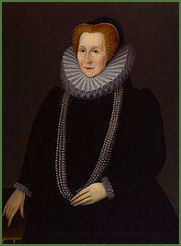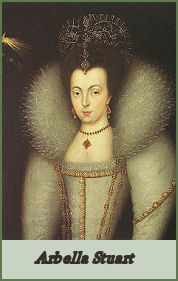Bess of Hardwick
 Bess of Hardwick was born Elizabeth Hardwick to John Hardwick and his wife, Elizabeth Leake, in the early 1520s, in the medieval manor house at Hardwick. Her father died before Bess had reached her first Birthday, leaving her with just a small dowry and, despite her mother re-marrying, the family remained poor. In attempt to remedy their dire financial situation, Bess was married her cousin Robert Barow at the age of 13, but sadly her young husband died a year later.
Bess of Hardwick was born Elizabeth Hardwick to John Hardwick and his wife, Elizabeth Leake, in the early 1520s, in the medieval manor house at Hardwick. Her father died before Bess had reached her first Birthday, leaving her with just a small dowry and, despite her mother re-marrying, the family remained poor. In attempt to remedy their dire financial situation, Bess was married her cousin Robert Barow at the age of 13, but sadly her young husband died a year later.
Whilst serving in the household of Frances Brandon, Duchess of Suffolk, the neice of King Henry VIII and mother of the nine day Queen, Lady Jane Grey, Bess was married for a second time to the extremely rich Sir William Cavendish. The present Dukes of Devonshire descend from this marriage. Cavendish purchased a number of properties, including Chatsworth House in the early years of their marriage. After 10 years of marriage Sir William died, leaving Bess a wealthy widow.
The ambitious Bess married for a third time two years later, to Sir William St. Loe, Captain of the Guard to Elizabeth I and Chief Butler of England. St. Loe died in 1564/5, leaving everything to Bess, who made a final and financially powerful marriage to George Talbot, 6th Earl of Shrewsbury.
During a visit of the Countess of Lennox in 1574, Bess engineered an advantageous match between her daughter, Elizabeth Cavendish and Charles Stuart, the Countess' son and the younger brother of Henry, Lord Darnley, who was the husband of Mary, Queen of Scots. The Lennox Stuarts had a feasible claim to the English throne, and since the consent of Elizabeth I was not solicited or obtained the marriage was considered potentially an act of treason. As a consequence, the Countess of Lennox was commited to the Tower of London by an outraged Elizabeth I and Bess was ordered to face an official inquiry, she astutely ignored the Queen's summons.
 Bess' granddaughter, Arbella Stuart, the child of the marriage, had a reasonable claim to the thrones of both Scotland and England and Queen Elizabeth I had indicated that Arbella might be named her heir. From 1569 to 1584 Bess and her fouth husband acted as 'guardians' to Mary, Queen of Scots, when the Scottish Queen was housed on their estates. At the same time Mary was removed from his custodianship, Shrewsbury and Bess separated. The legendary Queen of Scots is said to have been the cause of their quarrels, as Bess believed her husband to have indulged in a relationship with Mary.
Bess' granddaughter, Arbella Stuart, the child of the marriage, had a reasonable claim to the thrones of both Scotland and England and Queen Elizabeth I had indicated that Arbella might be named her heir. From 1569 to 1584 Bess and her fouth husband acted as 'guardians' to Mary, Queen of Scots, when the Scottish Queen was housed on their estates. At the same time Mary was removed from his custodianship, Shrewsbury and Bess separated. The legendary Queen of Scots is said to have been the cause of their quarrels, as Bess believed her husband to have indulged in a relationship with Mary.
On the death of the Earl of Shrewsbury in 1590, who had described Bess as "that sharp bitter shrew", she became Dowager Countess of Shrewsbury. Arbella Stuart, who Bess had ambitions to one day become Queen of England, was sometimes invited to her cousin Elizabeth's court, but spent most of her time with her grandmother at Hardwick. The relationship between Bess and Arbella deteriorated, Arbella was so restricted by her strict grandmother that she felt like a prisoner.
The pair quarreled irrevocably when Arbella attempted to elope with William Seymour, Lord Beauchamp, grandson of Lady Catherine Grey, who also had a plausible claim to England's throne. An action which resulted in Bess cutting Arbella from her will. Arbella Stuart never became Queen of England and died 'distracted' in the Tower of London. Her cousin James VI of Scotland, the son of Mary Queen of Scots and Henry Stuart Lord Darnley ascended the throne of England on the death of Elizabeth in 1603.
Bess continued with her building projects until her death at the age of eighty which took place at Hardwick Hall in 1608. She was buried at Derby Cathedral where her monument can still be seen.
Tutbury Castle- article on Tutbury Castle and Mary, Queen of Scots imprisonment there.
